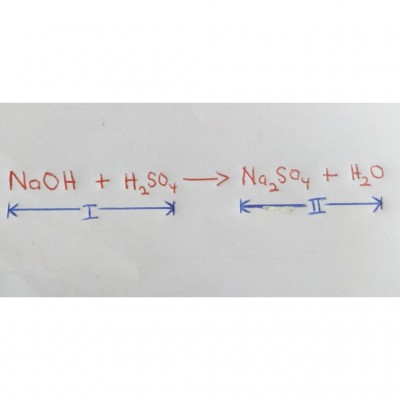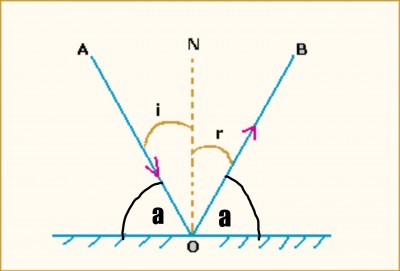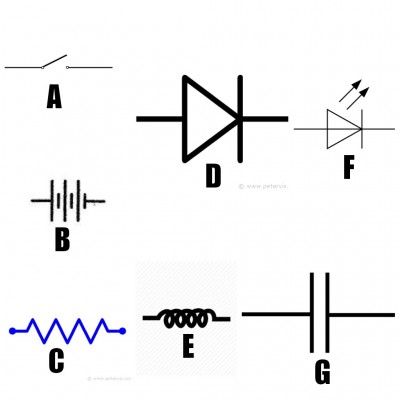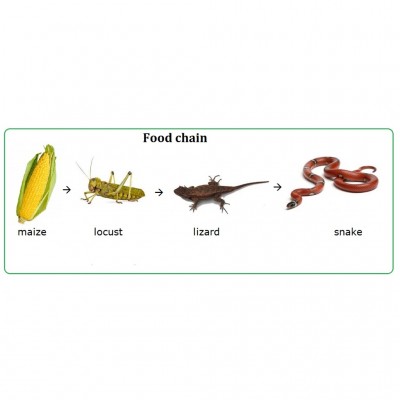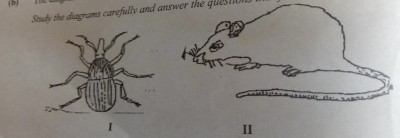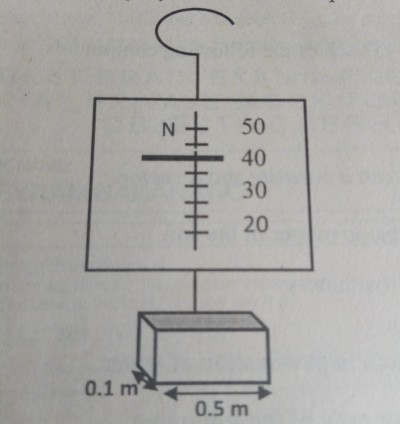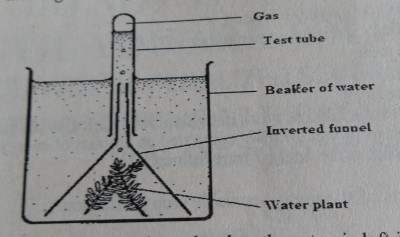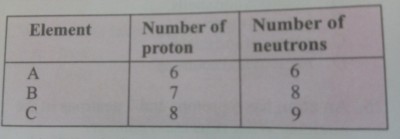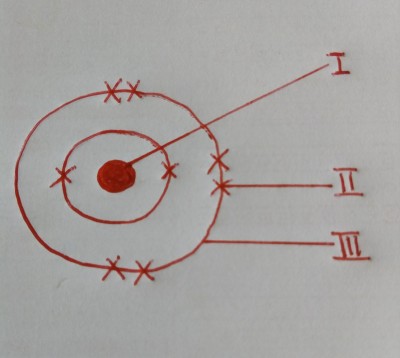QUESTIONS AND ANSWERS
The illustration shows a chemical equation which is not balanced. Study it carefully and answer the questions below:
a) What name is given to parts I and II in chemical reactions?
ANS: I-Reactants
II-Products
b) Write down the formula which represent the acid in the equation.
ANS: H2SO4
c) Write down the formula which represent the base in the equation.
ANS: NaOH
d) What type of reaction has been shown in the equation?
ANS: Neutralization reaction
e) Write a word equation for the reaction illustrated.
ANS: Sodium hydroxide reacts with sulphuric acid to produce sodium sulphate and water.
f) Write a balanced equation for the reaction illustrated.
ANS:
2NaOH + H2SO4 -----> Na2SO4 + 2H2O
The diagram illustrates a law under light energy. Study it carefully and answer the questions below:
a) What will be the appropriate title of the illustration?
ANS: Reflection of light
b) Name the parts of the lines labelled AO, OB and ON.
ANS: AO-Incident ray
OB-Reflected ray
ON-Normal
c) What name is given to angle i and r?
ANS: i-Angle of incidence
r-Angle of reflection
d) If angle a is 45°, calculate the value of angle i and r.
ANS: Angle i = 90° - a
= 90° - 45°
= 45°
Angle i = angle r
angle r = 45°
e) State the laws associated with the diagram.
ANS:
-The angle of incidence is equal to the angle of reflection.
-The incident ray, the reflected ray and the normal, at the point of incidence all lie in the same plane.
The diagrams shown illustrates electronic circuit symbols. Study them carefully and answer the questions below:
a) Identify each of the circuit symbols A, B, C, D, E, F and G.
ANS: A-Key
B-Battery
C-Resistor
D-Diode
E-Inductor
F-LED
G-Capacitor
b) State the function of each of the components labelled A, B, C, D, E, F and G.
ANS: A-It is used to turn the electric current on or off.
B-It converts chemical energy to electrical energy.
C-It is used to control the flow of electricity in a circuit.
D-It allows current to flow in one direction.
E-It opposes a sudden change in the flow of current.
F-It changes electrical energy to light energy.
G-For storing electrical charges.
The diagram illustrates a food chain in an ecosystem. Study it carefully and answer the questions below:
a) What does the arrow signify in the food chain?
ANS: It shows the direction of flow of energy.
b) Which of the organisms represent the producers in the food chain?
ANS: Maize
c) Which of the organisms is a herbivore?
ANS: Locust
d) Which of the organisms is a carnivore?
ANS: Snake
e) Name two other examples each of herbivores and carnivores.
ANS: Herbivore -goat, sheep, rabbit
Carnivore -Lion, tiger, cat, dog
f) Which of the organisms is the secondary consumer?
ANS: Lizard
The diagrams are illustrations of two common crop pests.
a) Identify the crop pests I and II and give two examples of crops attacked by each.
ANS: I-Weevil (maize, rice, millet, beans, wheat, etc)
II-Mouse/Rat (Beans, maize, groundnut, cassava, yam, etc)
b) Mention two harmful effects of the pest I.
ANS: *It destroys grains
*It causes low yield
*It leads to losses to the farmer.
c) State two methods of controlling the pest I.
ANS: *Spraying with chemicals.
*Hand picking
*Cultural control (it has to do with sanitation)
d) State two methods of controlling the pest II.
ANS: *Control by cats and dogs.
*Setting traps.
*Poison baits.
*Weeding the farm land.
The weight of a rectangular box is being measured below.
a) Name the instrument being used to measure the weight of the object.
ANS: Spring balance/Force or Newton meter
b) Read and record the weight of the object.
ANS: 40N
c) Calculate the area of the object.
ANS: Area = Length * Width
= 0.1 * 0.5
= 0.05 metre square
d) Determine the pressure the object would exert if placed on a flat surface.
ANS: Pressure = Force /Area
= 40N/0.05m2
= 800Pa
The set-up illustrates an experiment to show that a gas is given off during photosynthesis. Study the diagram carefully and answer the questions that follow:
a) What observation is made when the set-up is left in sunlight for some time?
ANS: Bubbles of gas begin to appear in the test tube.
b) Explain your observation made in (a) above.
ANS: The water plant undergoes photosynthesis, releasing oxygen as a by-product.
c) Name the gas collected in the test tube.
ANS: Oxygen
d) If a similar set-up is put in the dark for three hours, state and explain what will be observed.
ANS: No change would be observed. This is because photosynthesis would not occur due to the absence of sunlight.
Use the table to answer the questions below:
a) What is the mass number of A?
ANS: 12
b) What is the atomic number of B?
ANS: 7
c) Write the electronic configuration of elements B and C.
ANS: B=2,5
C=2,6
d) Predict the names of each of the elements represented by A, B and C.
ANS: A-Carbon
B-Nitrogen
C-Oxygen
The diagram shows the structure of an atom.
a) Name the atom.
ANS: Oxygen
b) Identify the parts labelled I, II and III.
ANS: I-Nucleus
II-Electron
III-Shell
c) State the number of protons contained in the atom.
ANS: 8 protons
d) State the atomic number of the atom.
ANS: Atomic number = 8
e) State the valency of the atom.
ANS: Valency = 2
f) What type of ion will the atom form?
ANS: Anion
g) Predict the charge of the atom.
ANS: Charge is -2
h) Name the two particles found in part labelled I.
ANS: Protons and neutrons
